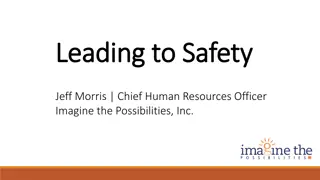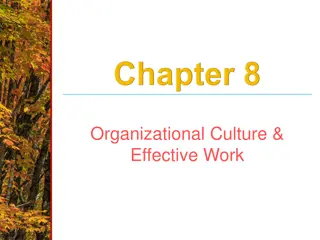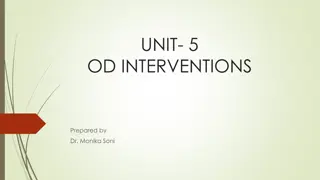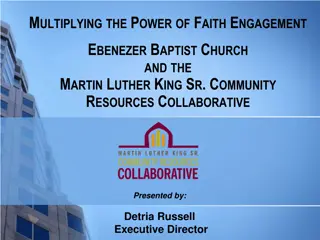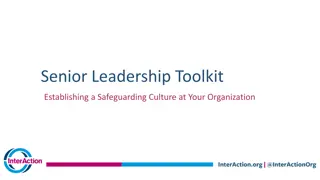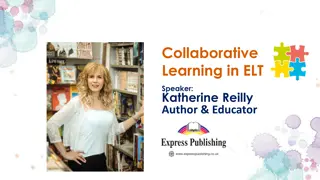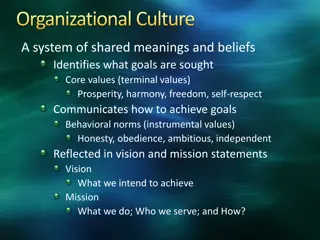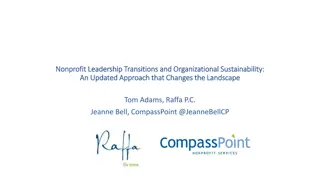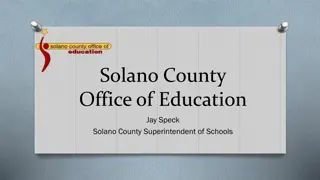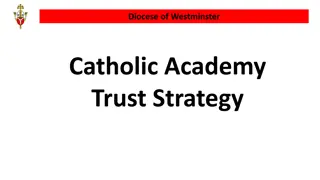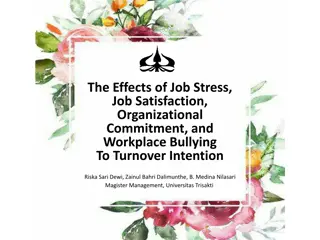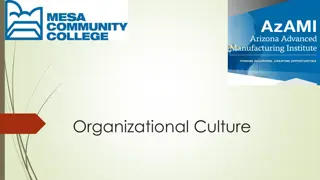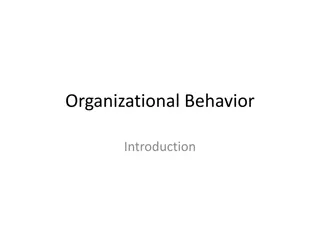Establishing Collaborative Organizational Culture in Schools
Cultivating a culture of collaboration is essential in educational settings to enhance teamwork, decision-making, and goal achievement. Organizational culture encompasses shared attitudes, values, and practices that shape behaviors. Dysfunctional cultures hinder progress, while types of organizational cultures vary from individualistic to collaborative. Collaboration involves direct interaction among equals working towards a common goal, fostering learning, inclusivity, and effective service delivery in schools.
Download Presentation

Please find below an Image/Link to download the presentation.
The content on the website is provided AS IS for your information and personal use only. It may not be sold, licensed, or shared on other websites without obtaining consent from the author.If you encounter any issues during the download, it is possible that the publisher has removed the file from their server.
You are allowed to download the files provided on this website for personal or commercial use, subject to the condition that they are used lawfully. All files are the property of their respective owners.
The content on the website is provided AS IS for your information and personal use only. It may not be sold, licensed, or shared on other websites without obtaining consent from the author.
E N D
Presentation Transcript
CREATING A CULTURE OF COLLABORATION IN SCHOOLS AND CLASSROOMS Long Island Pre-K Initiative Conference Best Practices for Teaching Pre-K and K Presentation by: Stephen J. Hernandez, Ed.D Hofstra University Hempstead, NY Stephen.J.Hernandez@ hofstra.edu
Organizational Culture What is culture? The set of shared attitudes, values, goals, and practices that characterizes a company or corporation (Merriam Webster Dictionary, 2005)
Culture and Organization Culture is something an organization has. The way we do things around here. (Deal,1993, p. 6). The philosophies, ideologies, concepts, ceremonies, rituals, values, and norms shared by members of the organization that help shape their behaviors (Connor & Lake, 1988). Culture includes norms such as task norms, task innovation norms, social relationship norms, and personal freedom norms (Lindahl, 2006). Organizational culture is the epicenter of change. (Deal, 1985, p. 303)
Dysfunction and Culture Dysfunctional cultures have: Inward focus Short-term focus Low morale Fragmentation Inconsistency Emotional outbursts Subcultures with contrary values All the above can impede organizational improvement (Deal and Peterson,1994).
Types of Organizational Cultures 1. Individualistic: stresses the needs of the individual over the needs of the group. People are seen as independent and autonomous. Social behavior tends to be dictated by the attitudes and preferences of individuals. 2. Balkanized: a culture made up of separate and sometimes competing groups. 3. Collaborative: a culture where the underlying norms, values, beliefs, and assumptions reinforce and support high levels of collegiality, team work, and dialogue about problems of practice. (Peterson, 1994)
What is Collaboration? A style for direct interaction between at least two co-equal parties voluntarily engaged in shared decision making as they work toward a common goal (Friend & Cook, 2003, p.5).
Why Collaborate? Individuals on effective teams learn to acknowledge mistakes, weaknesses, failures, and the need for help. They also learn to recognize and value the strengths of other members of the team and are willing to learn from one another. (DuFour, 2006) Collaboration is crucial component to the planning, delivery, and evaluation of special services and a means to achieving inclusion (Friend, 2011). And by the way Collaboration has been tied to the long term success of those served by it (Barnes and Turner, 2001).
8 Requires sharing resources Voluntary Based on parity Includes shared accountability for outcomes Collaboration Emergent Involves shared responsibility for key decisions Requires a mutual goal
9 Models of Collaborative Teams Least Collaborative Multidisciplinary Interdisciplinary Transdisciplinary Most Collaborative
Aspects of Collaboration: Collaboration is a way of being (Pugach & Johnson, 2002). The collaborative process reframes how people engage one another (Dettmer, Thurston, Knackendofell & Dyck, 2005). Collaboration is not an easy activity or process to engage in (Friend, 2000).
The Two Capacities of Collaboration Interpersonal capacity one s skills (interpersonal, communicative, professional confidence and capabilities. Organizational capacity organizational culture, support by leadership, administrative and institutional structures. (Hernandez, 2013)
Interpersonal Capacity of Collaboration Training in the complexities and nuances of collaboration (Conderman & Johnson-Rodriguez, 2009) . Learning to reflect on personal qualities (Conderman & Johnson - Rodriguez, 2009, p. 240). Greater self-confidence, leading to an enhanced willingness to collaborate (Spann-Hite, Picklesimer, and Hamilton, 1999). Parity amongst team members (Sileo, 2011). Attributes such as friendliness, honesty and the ability to listen (Kritikos, LeDosquet & Melton, 2010 & Fordham, L., 2014). Respect, trust and communication amongst team members (Wade, Welch, & Jensen, 1994).
Organizational Capacity of Collaboration Ingredients of organizational capacity organizational culture support by leadership administrative and institutional structures (Hernandez, 2013)
14 Specifics of Collaboration needed to serve young children with delays and disabilities Team members must recognize and respect the differences in training and specialization that each other bring to the table. Besides the specialties that a diverse team includes, teams serving children with delays and disabilities will be most effective when they include process-specific skills including: - Data collection for measuring change - Shared Leadership for managing the process - Generalization for building capacity throughout the classroom and school. (National Autism Center 2009)
Challenges to Collaboration Confusion regarding the differences between coordination and collaboration (Welch, 1998b). Others preferred to work independent of others (Ritzman, Sanger, & Coufal, 2006). Lack of training in effective collaborative engagement (Conderman & Stephens, 2000). Lack of interpersonal and inter-professional skills (Hernandez, 2014) Regulatory constraints impair effective collaboration/funding documentation requirements (Scalise, 2005). Schools lacked a collaborative culture or ethic (Tulbert, 2000) that includes parents and caregivers as equal participants
16 Specific Barriers to Effective Collaboration in Service to Young Children with Delays and Disabilities Differences in philosophy & methodology - research based is best! - may need to dispel preconceived notions. The work involved in learning a new approach. Managing all needs of children, including challenging behaviors all team members need to be on board! Patience (or lack thereof) with program implementation at home and in the classroom. (National Autism Center, 2009)
Collaborative Teams Need to Develop Skills In Group roles Stages of group development Leadership in small groups Effective communication Trust building Problem-solving, planning, and decision-making strategies Effective ways to conduct meetings Conflict resolution Group process evaluation (Maeroff, 1993)
Structures that Support Collaboration Shared decision-making and site-based management models Improvement planning teams inclusive of parents and caregivers. Regular and continuous communication of ideas, sharing of materials, and time to reflect on one's work Interdisciplinary projects and activities Team Engagement Peer observation Collective work on new approaches Collaborative decision-making and planning of professional development activities
Five Dysfunctions of a Team Lencioni, P.. (2005) Overcoming the Five Dysfunctions of a Team: A Field Guide for Leaders, Managers, and Facilitators. San Francisco: Jossey-Bass.
Creating a Collaborative Culture 6 Tasks (Peterson, 1994) 1. Building trust and rapport. - Find ways to increase the trust in the group and rapport in working together. - Trust building requires considerable attention. - Address resistance in the group and find ways to overcome it without coercion. - Engage in open and supportive communication as the work progresses. - Develop "shared influence" - Encouraging active participation of everyone. - Building trust and rapport are key!!!
Creating a Collaborative Culture 2. Diagnosing the organization. - Collaborative cultures support problem finding and the problem solving work of colleagues. - They know how to collect and analyze performance data - Formative & Summative Assessment - They are able to make a diagnosis of the situation and to share it in a clear and helpful way. - They place their diagnosis within a conceptual framework to aid in understanding the nature of the issue. - Diagnosis of problems models for others the deeper analysis that supports rich collaborative problem solving
Creating a Collaborative Culture 3. Dealing with the collaborative process. - Collaboration is a complex and demanding activity. - It requires developing trusting, collegial relationships; - Dealing with conflict in a productive way - Maintaining clear focus on the mission of organization. 4. Using resources and managing the work. - Joint work needs resources and coordination. - Effective organizations tap into the resource network to gain materials, ideas, time, and people to help.
Creating a Collaborative Culture 5. Collaborative work also requires more planning, organizing, and scheduling. It requires coordination. Leaders need to manage the workflow Leaders need to facilitate the direction and progress of work. Given the demands in most settings, leaders who help plan and organize joint work are very important.
Creating a Collaborative Culture 6. Building skill and confidence in others. - Team members need to build skills and confidence in coworkers. - Leaders help others develop leadership skills, planning skills, and problem solving skills. - Leaders increase the skills and knowledge of others through examples, ideas, and support. - Team members increase the confidence that others have in themselves and in the group as a whole.
Sustaining a Collaborative Culture - Previous efforts to promote collaboration pay off with an increased sense of efficacy by team members - the belief that they can have a substantial impact on the mission of the group. - Team members need to support one another team members self-efficacy impacted by social persuasion, or feedback from other team members (Bandura, 1997).
Problem-Solving in a Collaborative Culture Continue, modify, or select new process Evaluate the outcome Implement the process Assess potential solutions, select one Generate alternatives Identify the problem Create a climate for problem solving Frie nd 2011
27 Issues Related to Collaboration Team members need to support one another team member self-efficacy impacted by social persuasion, or feedback from other team members (Bandura, 1997). Need to evaluate the team and its effectiveness Mark Alexander Team Effectiveness Critique very helpful tool! THE TEAM EFFECTIVENESS CRITIQUE montfort.wikispaces.com/file/view/TEAMEFFECTIVENESSCRITIQUE -Nehadv2.doc
Evaluating the Collaborative Team Mark Alexander Team Effectiveness Critique Measuring team effectiveness is accomplished by examining the factors that lead to team development and effectiveness and measuring the team against these factors on a Likert scale measure from 1(low) to 7 (high). Nine Measures: 1. Shared goals and objectives measured on a continuum of There is a lack of commonly to Team members understand and understood goals and objectives. agree on goals and objectives. 2. Utilization of Resources All member resources are not recognized and/or utilized. to Member resources are fully recognized and utilized.
Evaluating Team Effectiveness Nine Measures according to Team Effectiveness Critique 3. Trust and Conflict There is little trust among to There is a high degree of trust members, and conflict among members, and conflict is evident. Is dealt with openly and worked 4. Shared Leadership One person dominates, and to There is full participation in leadership roles are not carried leadership; leadership roles out or shared. are shared by members. through. 5. Control and Procedures There is little control, and to There are effective procedures to there is a lack of procedures guide team functioning; team to guide team functioning. procedures and regulate members support these themselves.
Evaluating Team Effectiveness Nine Measures 6. Interpersonal Communications Communications between members are closed and guarded. participative. to Communications between members are open and 7. Problem Solving/Decision Making The team has not agreed on to The team has well-established approaches to problem solving and agreed on approaches to and decision making. problem solving and decision making. 8. Experimentation/Creativity The team is rigid and does not experiment with how different ways of doing things things are done. and is creative in its approach. to The team experiments with
Evaluating Team Effectiveness Nine measures Evaluation The group never evaluates to The group often evaluates its Its functioning or process. functioning and process.
Conclusion To reiterate what collaboration is: its a positive interdependence exists among team members who agree to pool resources and to operate from a foundation of shared values (Snell & Janney, 2005, p. 6)
Collaboration putting the puzzle together It is not just up to you!



